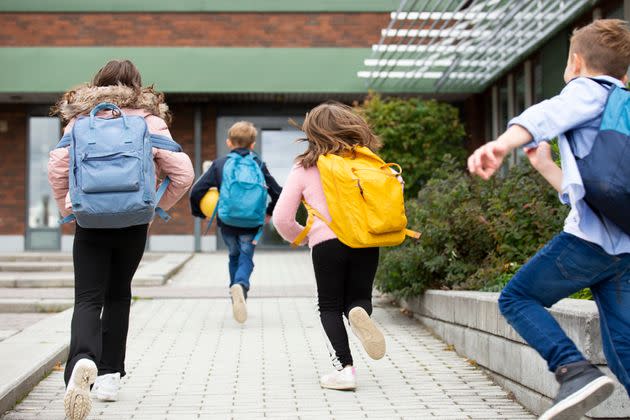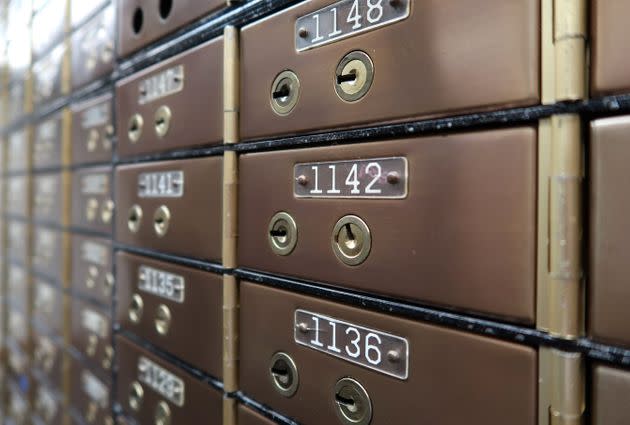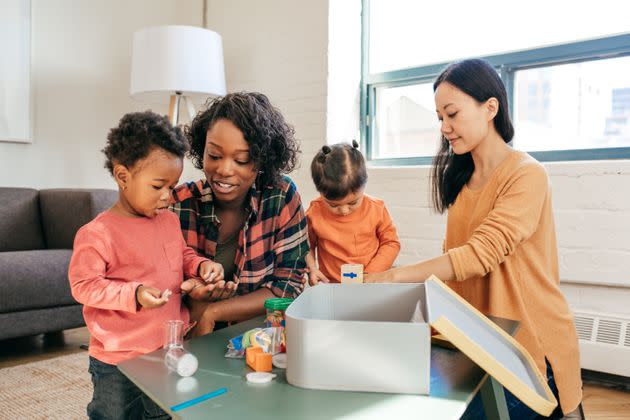What Parents Need To Know About Gun Safety
Abby Zwerner was teaching her classroom of first graders on Jan. 6 in Newport News, Virginia, when she was shot and seriously wounded.
The shooter was one of her students, a 6-year-old.
Steve Drew, the town’s police chief, explained in a press conference on Monday that the child’s mother had legally purchased the gun. The boy put it in his backpack and brought it to school.
The parent of another student in the class told The Washington Post that Zwerner was attempting to confiscate the weapon when she was shot.
Zwerner is in stable condition at an area hospital, and the school, Richneck Elementary, is closed for the week.
It’s terrifying to imagine this child picking up a gun in his little hands and zipping his backpack shut around it. But given how many guns there are in the U.S., it’s unsurprising that children access them — with often devastating results.
Firearms have become the leading cause of death for U.S. children, surpassing deaths by automobile accidents in 2020.
A 2018 report by the Small Arms Survey estimates 393 million civilian-held firearms in the United States. That’s more guns than in the other top 25 countries combined. The U.S. represents only 4% of the global population but has nearly 40% of the world’s firearms.
And gun ownership increased significantly during the pandemic, with 8.4 million people purchasing their first gun in 2020 and another 5.4 million in 2021.
Children live in many of these homes. The American Academy of Pediatrics (AAP) estimates that approximately one-third of U.S. children reside in a home with at least one gun and that 4.6 million children live with an unlocked, loaded weapon.
Given the ubiquity of guns, how can we keep our children safe?
School shootings tend to dominate our fears, but children are much more likely to be hurt or killed by a gun in their own homes and neighborhoods.
Here are some things we can do to reduce the odds that our children will be harmed by gun violence.

Reconsider having a gun in your home.
You may have had a firearm for years, but becoming a parent makes you see the world, and its risks, differently.
“It’s really important for parents to educate themselves about the risks around a decision to have a gun at home,” Nina Vinik, founder of Project Unloaded, told HuffPost.
One of the biggest risks for anyone with access to a gun is suicide. Kids who live in homes with guns are four times as likely to attempt suicide, and suicide attempts with firearms are fatal 90% of the time. When they attempt suicide with a firearm, nine out of 10 young people access the gun in their own home or the home of a relative.
Adults living in a home with a gun are more likely to die by suicide or homicide, meaning that the children in their homes are more likely to lose a parent or other caregiver.
Another real possibility is accidental death or injury in a home with a gun. Between 2015 and 2020, there were more than 2,000 unintentional shootings in which children shot themselves or others, according to Everytown for Gun Safety. Most of these shootings occurred in people’s homes, and when a child shot another person, it was almost always — 91% of the time — another child.
The trauma of these shootings has long-term impacts on those involved. For example, researchers found, in 2013-2104, that 13% of children reported having heard gunshots or seen someone shot by the time they were adolescents.
“We are all traumatized. Every single instance of gunfire that children are exposed to impacts their ability to learn, grow and develop,” Johanna Thomas, a social worker and Moms Demand Action volunteer in Arkansas, told HuffPost.
Deciding to bring a gun into your home is “not an irreversible decision,” Vinik said.
You can surrender a gun to your local police or contact the National Center for Unwanted Firearms for help with safe disposal. In addition, you can use a safety deposit box to maintain possession of your weapon but store it outside your home. These are often available at banks.

You can use a safety deposit box if you want to maintain possession of your gun but store it outside your home.
If you do have a gun at home, store it safely.
The AAP says that the safest home for a child is one without guns, but you can do things to prevent your child from accessing a weapon if you choose to keep one in your house.
“Research shows the most effective way to prevent children from accessing firearms is making sure all guns are stored, unloaded, locked and separated from ammunition. We’ve seen far too many reports of tragic incidents across the country where kids get their hands on guns that adults believe were stored securely, but they actually weren’t,” said Thomas, who identifies as a mother and a gun owner.
Thomas listed the following places where people sometimes keep their firearms, thinking they are hidden, but children can locate them relatively easily:
“An unlocked dresser or nightstand drawer; under a couch cushion, mattress or pillow; in an unlocked closet; or high on a shelf or on the top of the refrigerator.”
You may think your children don’t know that you own a gun or where the weapon is kept, but this is often untrue.
“Guns are in closets, nightstand drawers, backpacks, purses, the trunk of the car, where they’re just left out. Many children in gun-owning households know where their guns are, even when their parents don’t think they do,” said Thomas.
Thomas adds that parents must be vigilant about not leaving unsecured, accessible weapons in vehicles as well.
Pediatrician Dr. Janine Zee-Cheng told HuffPost that she asks all of her patients whether there is a gun in the home and, if so, how it is stored.
“I ask who has access to them and how that access is obtained (fingerprint, code, etc.),” Zee-Cheng said. “I also ask if people with access have been trained in their use. I then mention resources for firearm owners (the children’s hospital offers free trigger locks, and I have some in the office to give out if they like).”
In Indiana, where Zee-Cheng has her practice, she says it is common for children to live in a home with a gun.
Ask about guns in the homes of friends, neighbors and relatives.
It’s not the first question that comes to mind when scheduling a playdate or sleepover, but you need to ensure that your child will not come across an unsecured weapon anywhere they may be playing.

Asking if any guns are in the home before a playdate ensures your child will not encounter an unsecured weapon anywhere while playing.
Just as you want to ensure there will be an adult in the home when you send your child over, “similarly, parents need to know about the presence of guns,” said Vinik.
“It’s also important to ask those questions, just to create norms,” she added. You can add it to your checklist for playdates, alongside letting others know about any allergies your child has and making sure the adult in charge has your phone number.
If they have a gun in the home, ask how it is stored, ensuring the safety precautions described above are met.
Understand the limits of talking to your child about guns.
You probably want to tell your children never to touch a gun, even if they aren’t sure whether or not it’s real. And you should do so — but know that the impact of these messages is limited.
Research shows that children often ignore such warnings when confronted with a real firearm.
Data also suggests that kids know more about the weapons in their homes than their parents think they do.
“Kids know where their parents store guns, and more than one-third reported handling their parents’ guns, many doing so without the knowledge of their parents. Nearly one-quarter of parents didn’t know that their children had handled the gun in their house,” said Thomas, who suggests that parents see talking to their kids about gun safety as a precaution, not a guarantee.
Zee-Cheng thinks it’s appropriate for parents to begin talking about gun safety when they notice their children engaged in pretend play involving guns — which, she adds, is normal for all kids.
“Kids are aware of guns from their peers and from media from a very young age,” said Zee-Cheng.
Another reason to broach the topic is school lockdown drills, which Zee-Cheng said “can be enormously stressful. At a minimum, parents should allow kids to debrief after lockdown drills and to ask what they understand about the drills.”
Parents who have concerns about their school’s safety plan or who want to take an active role in creating it may be able to join a school or district’s safety team.
Jill Lemond, director of education at Evolv Technology and former assistant superintendent of safety and school operations at Oxford Community Schools in Oxford, Michigan, believes that these teams should be comprised of “administrators, principals, teachers, emergency responders, members of the local police and fire departments, community members, such as coaches, that are directly involved with students, and parents.” Older students can also participate.
Lemond pointed to weapons confiscated during screening procedures that were prevented from entering school buildings as evidence that preventative measures can have an impact.
The communal effort involved in creating and implementing safety plans, Lemond explained, also provides its own sort of protection.
“Creating an environment of safety,” Lemond added, “where everybody in the community feels empowered and that they can and do play an active role in keeping students safe, also helps to decrease the likelihood of an incident.”
